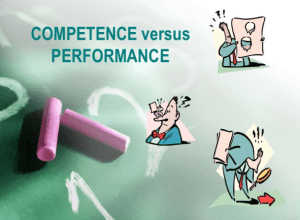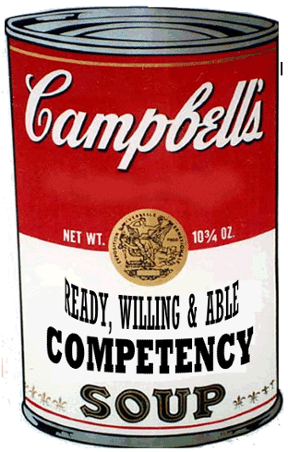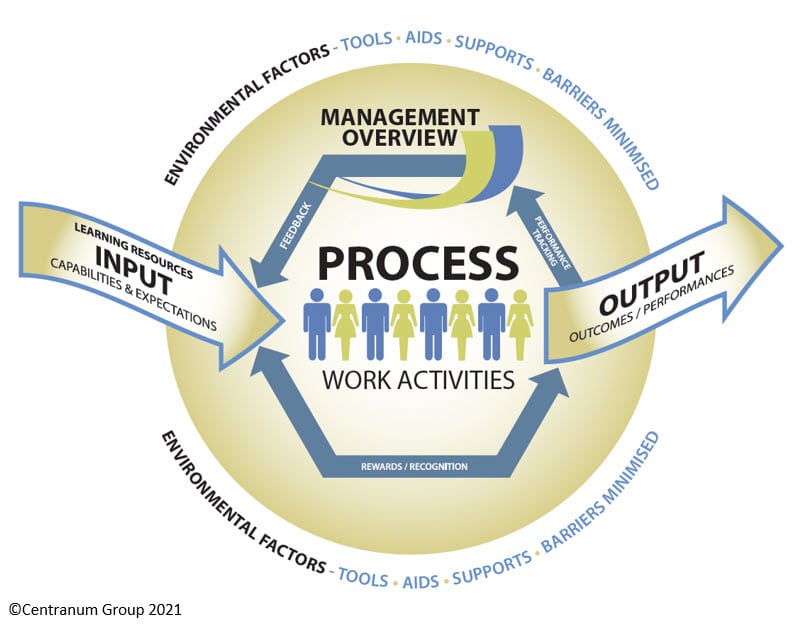
Competency and Performance - the concepts
How is the term 'competency' used?

‘Competency’ is sometimes defined as a particular knowledge or skill standard to be achieved.
More frequently it is defined as part of a behavioral repertoire – a set of behaviors that successful people demonstrate. It is assumed these behaviors have led to their success.
If the first assumption is true it follows that if others adopt the same set of behaviors then they too will be successful.
The term ‘Competency’ is also often used interchangeably with the term ‘Competence’.
How is the term 'performance' used
In the performance management context ‘Performance’ usually means work activities and behaviours – much the same meaning as a competency. Competencies are very often part of a performance appraisal, so the concepts of Competency and Performance seem to be overlapping.
A popular approach is to say that tasks describe what is to be done and competencies describe how those tasks should be done. Or that there are task behaviors and citizenship behaviors often termed ‘soft skills’.
It has been pointed out that the lack of commonly accepted terminology means that organisations “build and integrate HRM systems on a bed of shifting sand”.
Competency & Performance are not the same
The confusion stems from the use of the same terminology for both contexts. Competencies are often defined as ‘behaviors’ and assessed by ‘performance’ indicators.
When competency terminology is changed so that competencies have ‘descriptors’ and ‘standards’ that are ‘ met’ , ‘not met’ or ‘needs development’ the confusion disappears.
What is competency?
A competency is a particular aspect of knowledge and/or a distinct skill. Skills are a series of procedural steps or actions. They are used to complete tasks in the workplace. A task may require a bundle of knowledge and skills. Systematic job analysis is used to determine the knowledge and skills needed to complete a task successfully.
What is performance?
Most organizations try to align individual performance with organizational purpose and strategies. In order to do this the definition of ‘performance’ should include the results that will contribute.
However ‘Expected Performance’ in job descriptions is usually defined as a list of tasks, rather than the outputs of those tasks. Just performing a task will not necessarily produce the results that the organization is looking for.
As an example ‘ Provide help desk services’ is a task – but this says nothing about the desirable outputs.
Due to the poor quality of most job descriptions most performance management systems are not based on the individual’s job role. Even though the individual’s job is at the heart of the contract between worker and employer.
Instead most performance management systems use ‘management by objectives’. ‘SMART’ goals have to be written at least annually, creating unnecessary administrative workload.
Another problem is that the SMART goals are also often poor quality. Many are defined as tasks rather than measurable outcomes.
It is better to define performance in terms of both tasks and their expected outcomes, in a job description that is a living document.
What is the link between competency and performance?
A useful approach is to use systems thinking. To view individual workplace performance from the perspective of a system.
A system has inputs, processes and outputs. It operates in an environment. It has a control or feedback mechanism.
Inputs
From this perspective the inputs to individual workplace performance are job expectations – expected tasks and results. Competencies are the knowledge and skills needed to deliver on the job expectations.
The most common reason for poor performance is that expectations are not clear.
Process
Work activities are the process part of the system. Capability/Competency is need to successfully perform the work tasks. The second most common reason for poor performance is lack of competence.
Output
Finally job results – output – is the result of the task activity.

Alignment is Key
If job expectations are aligned to the objectives of the organization then the output will be results that contribute to organizational success.
If expectations are not aligned, then work activities will not contribute. The activity is a wasted resource, even perhaps detrimental.
Read more on how to align individual performance and capability objectives with your organization’s strategy and direction.
FAQs
What’s the difference between competency and performance?
Competency describes the behaviors and capabilities someone demonstrates (inputs). Performance is the result achieved against goals or expectations (outputs). Results – successful job performance depend on competency.
How do they work together in performance reviews?
We measure what was delivered against Goals and Role based OKRs. We use competencies to assess how it was delivered. Discuss both to balance outcomes with behaviors and risk.
Should competencies have their own rating separate from goals?
Yes. Keep a distinct competency rating and separate ratings for goals and OKRs. You can weight them to show relative importance. Less weight for competencies (typically 70-90% on output/results and 10-30% for competencies). Ideally just an overall rating for values based competencies because their broad definition means they are assessed subjectively.
How do we reduce bias in competency ratings?
Use competency descriptions that are as specific as possible to your context. Train evaluators to be aware of potential bias. Ask for comments and examples as evidence to justify the rating. Ensure the rating scale clearly distinguishes between different degrees of competence. Use within and between rater calibration to track rater patterns and promote fairness.
Should competency ratings affect pay or promotion?
Research shows that most values based behaviours ratings reflect the supervisor staff relationship rather then the actual behaviours. So ideally they are informative and used primarily for developmental purposes. Weight them lightly in relation to results and link to pay/promotion only with clear governance and calibration to prevent double-penalizing or favoritism.
What’s the difference between a performance plan and a competency improvement plan?
A performance plan addresses missed outcomes – job results. A competency plan targets behaviors/capabilities to achieve future outcomes more reliably and safely.
